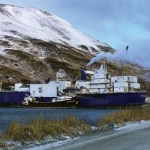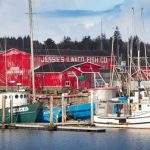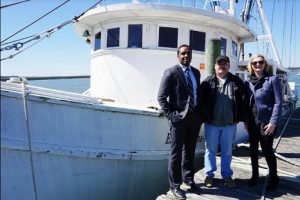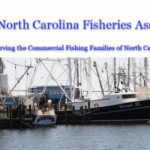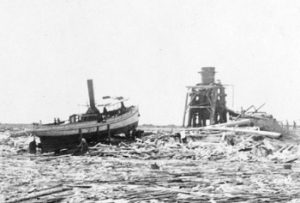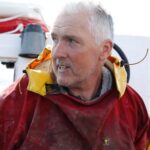Tag Archives: wind energy areas
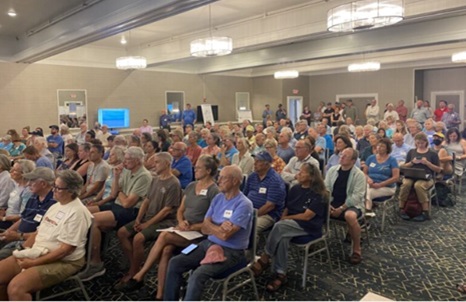
BOEM Hears Mostly Opposition at a Meeting in Eastham
Local officials on the Outer Cape have for a month been calling for the Bureau of Ocean Energy Management (BOEM) to hold a public information session here about one of eight proposed wind energy areas in the Gulf of Maine — the one sited about 20 miles off Cape Cod’s back shore — before its size and shape are approved. BOEM, the agency of the Dept. of Interior that is charged with managing the development of offshore wind, finally did that on June 17, and some 200 people turned out at the Four Points by Sheraton for it. BOEM announced the meeting only six days before it was held. Statements about possible negative effects of the development on commercial fishing dominated the meeting. Many of those who spoke identified themselves as fishermen or the wives of fishermen and said that they feared their livelihoods would be lost because of the construction of wind turbines. Truro lobsterman Dana Pazolt said he believes the cables would serve as a barrier to lobster migration. “You run the wires across the seabed, our industry is dead,” he said. more, >>CLICK TO READ<< 20:43
Oregon: Fishing group reacts to BOEM news on offshore wind
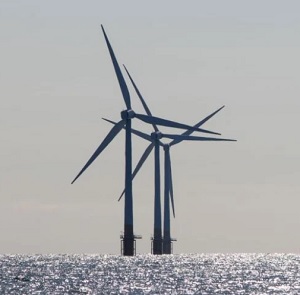 Despite overwhelming opposition from tribes, fishing organizations and coastal communities, the Bureau of Ocean Energy Management (BOEM) announced the release of the final wind energy areas (WEAs) off Oregon’s south coast today. The WEAs remain unchanged from the draft areas released earlier this year. State agencies, fishermen, environmentalists, state legislators and others raised significant concerns about the draft WEAs, apparently to no avail. “This is a slap in the face to the many stakeholders who have been trying to engage with BOEM for the last few years,” said Heather Mann, Director of the Midwater Trawlers Cooperative. “BOEM is a rogue federal agency pushing a dangerous agenda largely unchecked. BOEM will stop at nothing until our oceans are littered with wind turbines and all just to meet an arbitrary political deadline.” more, >>click to read<< 10:24
Despite overwhelming opposition from tribes, fishing organizations and coastal communities, the Bureau of Ocean Energy Management (BOEM) announced the release of the final wind energy areas (WEAs) off Oregon’s south coast today. The WEAs remain unchanged from the draft areas released earlier this year. State agencies, fishermen, environmentalists, state legislators and others raised significant concerns about the draft WEAs, apparently to no avail. “This is a slap in the face to the many stakeholders who have been trying to engage with BOEM for the last few years,” said Heather Mann, Director of the Midwater Trawlers Cooperative. “BOEM is a rogue federal agency pushing a dangerous agenda largely unchecked. BOEM will stop at nothing until our oceans are littered with wind turbines and all just to meet an arbitrary political deadline.” more, >>click to read<< 10:24Oregon fishermen, tribes angered by surprise announcement on offshore wind energy areas
 Federal officials say Oregon’s wind energy areas were developed “following extensive engagement and feedback from the state, Tribes, local residents, ocean users, federal government partners, and other members of the public” and are based on reducing conflicts with ocean users, particularly commercial fishermen. The areas avoid 98% of the locations recommended for exclusion due to their importance as commercial fishing grounds, they said. But local groups representing fishermen and Indigenous communities said that narrative is inaccurate and the federal government’s engagement with local communities was perfunctory at best, failing to take into account suggested impacts on local fishing areas, the environment and views that are sacred to tribes. The groups said the announcement caught them by surprise since Gov. Tina Kotek had asked the federal agency last June to pause identifying and leasing offshore wind areas so the state could fully evaluate potential impacts on the environment and economy. more, >>click to read<< 10:07
Federal officials say Oregon’s wind energy areas were developed “following extensive engagement and feedback from the state, Tribes, local residents, ocean users, federal government partners, and other members of the public” and are based on reducing conflicts with ocean users, particularly commercial fishermen. The areas avoid 98% of the locations recommended for exclusion due to their importance as commercial fishing grounds, they said. But local groups representing fishermen and Indigenous communities said that narrative is inaccurate and the federal government’s engagement with local communities was perfunctory at best, failing to take into account suggested impacts on local fishing areas, the environment and views that are sacred to tribes. The groups said the announcement caught them by surprise since Gov. Tina Kotek had asked the federal agency last June to pause identifying and leasing offshore wind areas so the state could fully evaluate potential impacts on the environment and economy. more, >>click to read<< 10:07
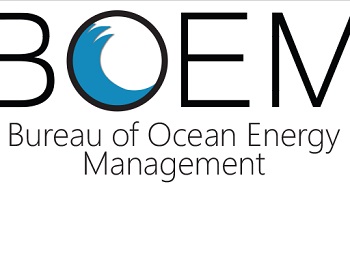
BOEM Schedules In-Person Informational Meetings on Offshore Wind in the Gulf of Maine
BOEM invites you to attend in-person meetings in Massachusetts, New Hampshire, and Maine in July 2023. BOEM is seeking feedback and local knowledge from the Gulf of Maine fishing community to facilitate improvements in spatial models used to inform draft Wind Energy Areas in the Gulf of Maine. The in-person meetings will provide opportunities to meet with BOEM staff, learn about the data BOEM has received for the models, and provide feedback on how their spatial models are incorporating the data. The meetings will include a mixture of small-group conversations and plenary speakers. Additional opportunities to comment will be available after the meetings. >click for schedule and locations< 16:49
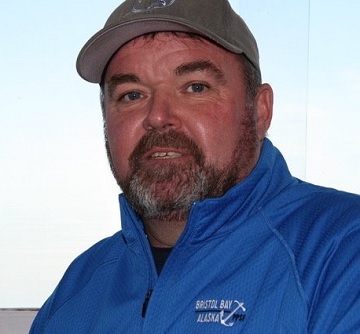
100 MPH Process: Fisherman Dewey Hemilright of Wanchese, NC on Wind Energy
“Sometimes I wish I wasn’t so entrenched in this stuff,” commercial longline fisherman Dewey Hemilright said. “It’s hard to turn my mind off.” Hemilright, who fishes out of the northern Outer Banks village of Wanchese, serves on the federal Mid-Atlantic Fisheries Management Council as well as numerous advisory committees. Lately he has turned his attention to offshore wind energy and its potential impacts on fisheries, including commercial, recreational, and for-hire charter businesses. “I don’t think people understand the magnitude of these wind energy areas from Maine to South Carolina, a massive amount of acreage if you add it all up, and what a disruption to the seafood industry this could be,” he said. “And the leases are going for such huge amounts of money I worry that the commercial fishing industry will amount to a grain of sand on Jockey’s Ridge.” Hemilright calls the recent acceleration in ocean bottom leasing a “100 mile-per-hour process.” >click to read< 10:29


































